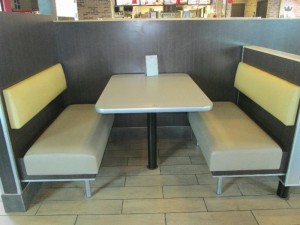ADA and Furniture
Posted on - Thursday, April 24th, 2014In the ADA Standards you will not find any mention of furniture. Furniture is not scoped in the Standards because they are not permanent or built-in fixtures. This omission is confusing to designers since they still have to provide aspects of their facilities with equal access to persons with disabilities. Sometimes designers provide the accessible service by providing a movable piece of furniture, but that would not be acceptable per the ADA Standards.
The ADA is only concerned with permanent fixtures. According to the Department of Justice Code of Federal Regulations:
“Scope of coverage. The 1991 Standards and the 2010 Standards apply to fixed or built-in elements of buildings, structures, site improvements, and pedestrian routes or vehicular ways located on a site. “
This newsletter will explain where in the Standards this is mentioned and how furniture plays a role in the ADA.
Dining Surfaces
ADA Section 226 requires that 5% of dining surfaces that are provided for the consumption of food or drink whether for sitting or standing shall be accessible. But these only apply to fixed surfaces. Tables that are not fixed do not count in the 5% count.

This photo shows fixed booth but a non-fixed table. This would not count as the accessible dining surface unless there are no other fixed tables or counters in the establishment and all the dining was made up of furniture.

This photo shows a fixed counter but also fixed stools without a space for a wheelchair. This is also a non-accessible dining surface

This dining surface is made of two non-fixed tables put together. If this is the only dining surface available, it also would not comply because the legs and support at the floor does not give a clear 30″ wide space. The base is in the way. Even if the base was less than 1/4″ high, the clear floor space at the wheelchair area is not allowed to have a level change.

This photo shows a table with a center post that does not provide a 17″ minimum of depth

This photo shows a fixed counter without any level changes at the ground. This would be considered an accessible dining surface since there is 30″ of width at the floor.

Because 5% of the fixed dining counters must comply, a bar where a bar tender works does not have provide a lower accessible portion as long as there is another fixed counter in the same bar area that is lower and meets the requirements and as long as that counter will have the same service as the main bar.
Work Surfaces
There are two types of work surfaces: Employee and Non-Employee work surfaces.
The ADA Standards require that non-employee work surfaces comply with section 902.
Employee work surfaces are exempted if located within a work area (where they perform work). Since the ADA standards only apply to fixed millwork, workstations made of systems or modular furniture that is not fixed will not be required to comply, even if it’s in a public area.
Advisory 206.2.8 Employee Work Areas Exception 1. Modular furniture that is not permanently installed is not directly subject to these requirements.

these library study carrels are fixed and therefore 5% must be accessible.

this library table is not fixed and therefore cannot be counted as part of the 5% accessible work surface

The tables in this classroom are not fixed and therefore there is no requirements for access per section 902. Of course it gets complicated if this is a public school. Then the program offered must be made available per Title II. That discussion is beyond the scope of this newsletter.

The tables in this classroom are fixed and 5% must be accessible
Sales and Service Counters
ADA Section 227 requires that one of each type of sales and service counter be accessible. If there are several types that are dispersed, then the accessible counters should also be dispersed.
A reception desk that is made of system’s furniture is not required to meet the requirement of section 904.


This reception counter is made of system’s furniture and would not require a lower accessible counter.
By the same token, if there are fixed sales or service counter that are not accessible, a person with disabilities should not be sent to a different non-fixed table that might not be located at the same place as the fixed counter.

This sales counter will require a lower portion because it is a fixed counter.
More Information
If you need a barrier free/HSW CEU check out our webinar for GreenCE “How Accessible is your Work place”. Thursday April 10th at 12:00 p.m. CST
We are celebrating our 10th year of service to the building industry as a Registered Accessibility Specialist! Mention this newsletter and receive 10% off your next review or inspection.
If you want to learn more about these standards, be sure to check out my books:
“Applying the ADA” published by Wiley.
They are available for sale now. (also available as an e-book)
If you have any questions about these or any other topics, please feel free to contact me anytime.
Marcela Abadi Rhoads, RAS #240
Abadi Accessibility
214. 403.8714
marhoads@abadiaccess.com
www.abadiaccess.com
 Abadi
Abadi 


